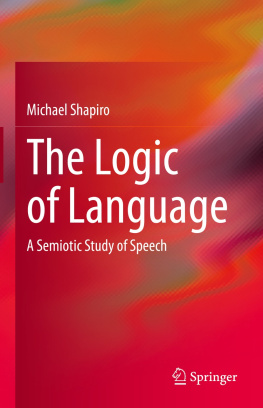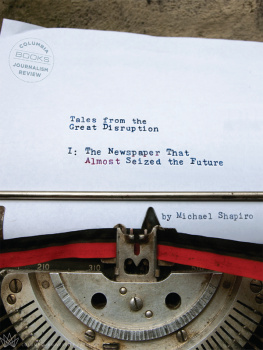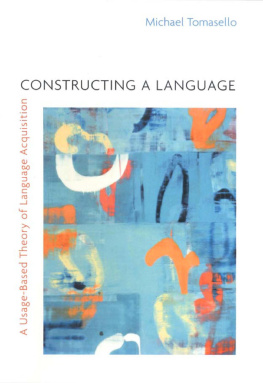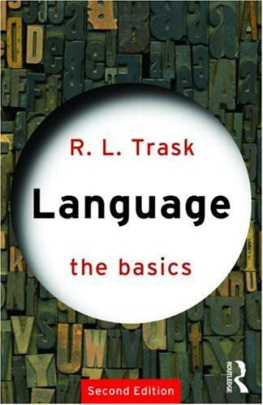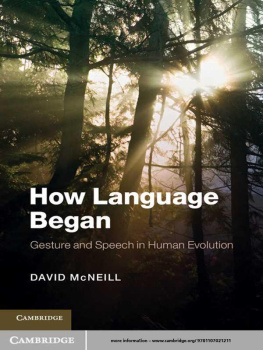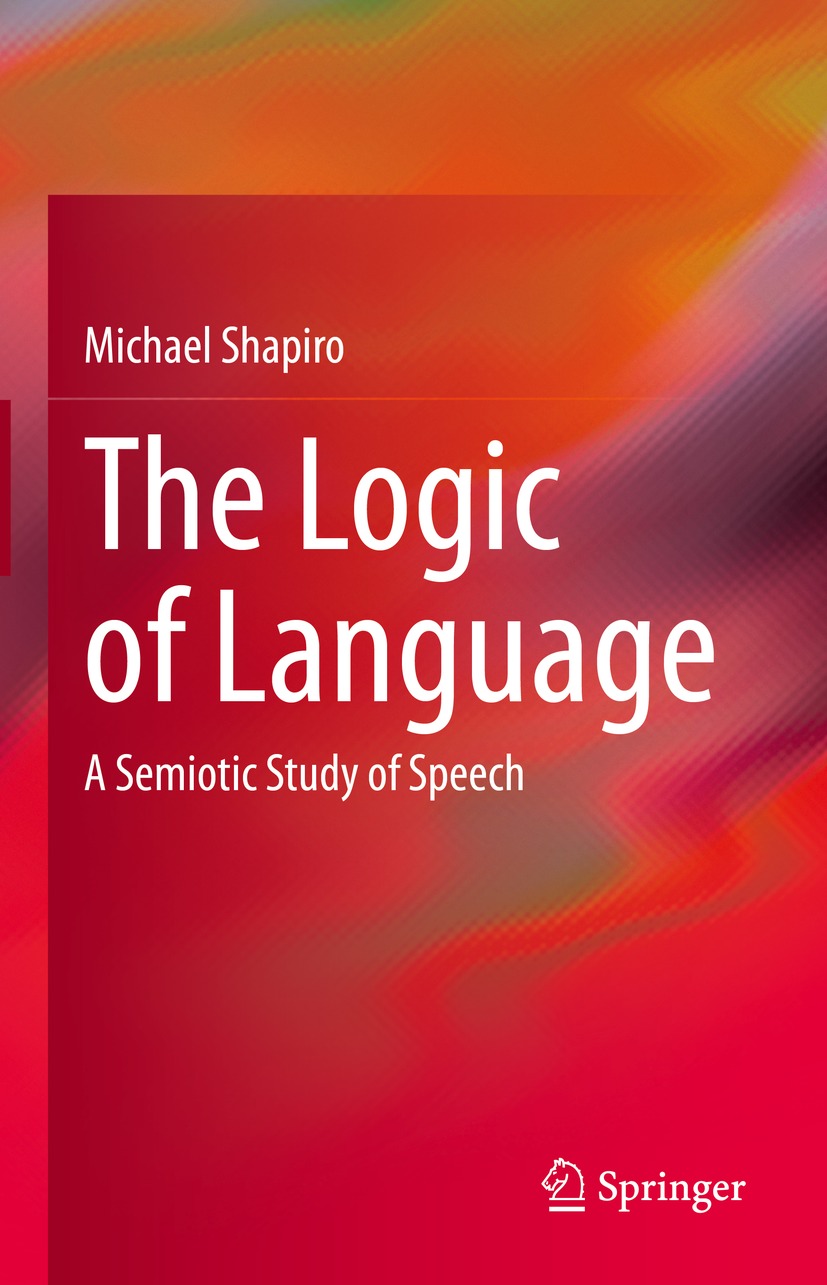Michael Shapiro
The Logic of Language
A Semiotic Study of Speech

The Springer logo.
Michael Shapiro
Manchester Center, Vermont, USA
ISBN 978-3-031-06611-5 e-ISBN 978-3-031-06612-2
https://doi.org/10.1007/978-3-031-06612-2
The Editor(s) (if applicable) and The Author(s), under exclusive license to Springer Nature Switzerland AG 2022
This work is subject to copyright. All rights are solely and exclusively licensed by the Publisher, whether the whole or part of the material is concerned, specifically the rights of translation, reprinting, reuse of illustrations, recitation, broadcasting, reproduction on microfilms or in any other physical way, and transmission or information storage and retrieval, electronic adaptation, computer software, or by similar or dissimilar methodology now known or hereafter developed.
The use of general descriptive names, registered names, trademarks, service marks, etc. in this publication does not imply, even in the absence of a specific statement, that such names are exempt from the relevant protective laws and regulations and therefore free for general use.
The publisher, the authors and the editors are safe to assume that the advice and information in this book are believed to be true and accurate at the date of publication. Neither the publisher nor the authors or the editors give a warranty, expressed or implied, with respect to the material contained herein or for any errors or omissions that may have been made. The publisher remains neutral with regard to jurisdictional claims in published maps and institutional affiliations.
This Springer imprint is published by the registered company Springer Nature Switzerland AG
The registered company address is: Gewerbestrasse 11, 6330 Cham, Switzerland
Books by Michael Shapiro
On Language and Value in American Speech: With a Semeiotic Appendix. Pp. 139. Riga (Latvia): Lambert Academic Publishing, 2019.
The Speaking Self: Language Lore and English Usage. 2nd, expanded ed. Springer Texts in Education. Pp. xxviii, 517. New York: Springer Nature, 2017.
The Speaking Self: Language Lore and English Usage. Pp. xix, 303. Scotts Valley, Calif.: CreateSpace, 2012.
The Sense of Form in Literature and Language [coauthor, Marianne Shapiro]. 2nd, expanded ed. Pp. xxi, 373. Scotts Valley, Calif.: CreateSpace, 2009.
Palimpsest of Consciousness: Authorial Annotations of My Wife the Metaphysician, or Lady Murasakis Revenge. Pp. 276. Charleston, S. C.: BookSurge Publishing, 2007.
My Wife the Metaphysician, or Lady Murasakis Revenge [fiction]. Pp. [x], 362. Charleston, S. C.: BookSurge Publishing, 2006.
The Sense of Form in Literature and Language [coauthor, Marianne Shapiro]. Semaphores and Signs. Pp. viii, 215. New York: St. Martin's Press, 1998.
The Sense of Change: Language As History. Advances in Semiotics. Pp. xiv, 146. Bloomington: Indiana University Press, 1991.
Figuration in Verbal Art [coauthor, Marianne Shapiro]. Pp. xv, 286. Princeton, New Jersey: Princeton University Press, 1988.
The Sense of Grammar: Language As Semeiotic. Advances in Semiotics. Pp. xiv, 236. Bloomington: Indiana University Press, 1983.
Structure and Content: Essays in Applied Semiotics [coauthor, Marianne Shapiro]. Monographs, Working Papers and Prepublications of the Toronto Semiotic Circle, 1979/No. 2. Pp. 69. Toronto: Victoria University, 1979.
Hierarchy and the Structure of Tropes [coauthor, Marianne Shapiro]. Studies in Semiotics, 8. Pp. v, 37. Bloomington: Indiana University, 1976.
Asymmetry: An Inquiry into the Linguistic Structure of Poetry. North-Holland Linguistic Series, 26. Pp. xiv, 231. Amsterdam: North-Holland, 1976.
Aspects of Russian Morphology: A Semiotic Investigation. Pp. 62. Cambridge, Mass.: Slavica, 1969.
Russian Phonetic Variants and Phonostylistics. University of California Publications in Linguistics, 49. Pp. x, 55. Berkeley: University of California Press, 1968.
Preface
This book is intended as a companion volume to one of my other books, The Speaking Self: Language Lore and English Usage (2nd ed., 2017), which incorporates revised versions of posts on my blog, www.languagelore.net . It is hoped that the present volume will serve as a basis for the exploration of language in a more systematic way. For example, a college instructor wishing to use it as a textbook may consider assigning excerpts from The Speaking Self by way of exemplification of basic points and approaches to analysis. I believe that the two volumes used in tandem will provide a solid grounding in the observational science of linguistics, linking theory with practice in a way that will expand a students understanding of language as a global phenomenon.
Readers familiar with two of my earlier books, The Sense of Grammar: Language as Semeiotic (Indiana University Press, 1983) and The Sense of Change: Language as History (Indiana University Press, 1991)both of which are no longer in printwill see that the present volume is the product of collating much of the material of these two Sense books and providing a fresh frame of reference in order to make the amalgamation effective and comprehensible.
My own conception of language is tinctured by my polyglot background and by my more than half-century experience as a research scholar and university professor (UCLA, Princeton, UC Berkeley, Brown, Columbia). I was born in Yokohama (Japan) before World War II and grew up speaking three languages simultaneously, Russian, Japanese, and English, in a family of Russian-Jewish migrs who spent 25 years in Japan. My parents habitual languages were Russian, English, German, French, and Japanese, all of which they spoke fluently. Although my mother tongue is Russian, almost all my formal education was in schools in which English was the language of instruction. Having spent the war years in Japan, I immigrated to Los Angeles at the age of 12 and attended high school, college, and graduate school in America. The only exception was a postdoctoral year (19651966) spent at Tokyo University, where I brushed up on my written Japanese and did some research on the contemporary language. After that I specialized in Slavic linguistics and poetics, in the first instance, and in semiotics (the theory of signs) thereafter, applying the whole philosophy of the American logician and scientist, Charles Sanders Peirce (18391914), as a framework for the analysis of language and literature.
Those who know the history of linguistics in the twentieth century will recognize that the title of this book has been influenced by my namesake Edward Sapirs classic Language (1921)with two important modifications: the insertion of the words Logic and Semiotic. (Shapiro and Sapir are variants of the surname Shpira, the Hebrew/Yiddish version of Spira [Hebrew: , pronounced Shpira], the medieval name of the city Speyer in Germany.) Here the reason may not be clear. It is in fact a nod in C. S. Peirces direction, whose conception of logic as a normative science amounts to regarding it as a theory of knowledge. The phrase logic of language is, therefore, meant to show how I conceive the patterned relationships constituting the structure and history of language. The analyses of linguistic phenomena offered here will accordingly strive to make this conception clear in all of languages aspects, but most notably in its variegated uses as the instrument of thought and speaking.

